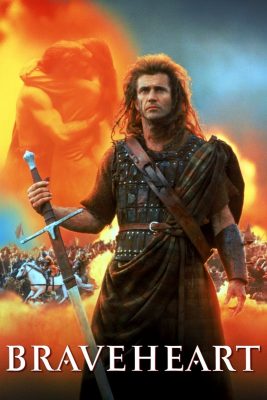
In 1280, Scotland is invaded and conquered by King Edward “Longshanks” after the death of Alexander III of Scotland, who left no heir to the throne. Young William Wallace (Mel Gibson) witnesses the brutality of Longshanks’ rule, including the execution of Scottish nobles, and the deaths of his father and brother, who fought against the English. Wallace’s paternal uncle Argyle takes him on a pilgrimage throughout Europe, where he receives a broad education.
Return to a Conquered Homeland
Years later, Wallace returns to a Scotland where Longshanks has granted his noblemen land and privileges, including the right of “jus primae noctis”. Wallace reunites with his childhood friend Murron MacClannough (Catherine McCormack), and they marry in secret. However, when Wallace rescues Murron from being raped by English soldiers, she is captured and executed. Seeking vengeance, Wallace rallies his clan against the English garrison in his hometown, sending a defiant message of rebellion to Longshanks.
Rise of the Rebellion
Longshanks orders his son Prince Edward to quell Wallace’s rebellion. However, Wallace’s victories against the English earn him a growing number of followers from various clans. His greatest triumph comes at the Battle of Stirling Bridge, where he defeats the English commander Cheltham. With his friend Hamish (Brendan Gleeson), Wallace continues his insurrection, seeking the assistance of Robert the Bruce (Angus Macfadyen), the son of a Scottish nobleman and contender for the Scottish crown.
Betrayal and a New Ally
Amidst the threat of rebellion, Longshanks sends Isabella of France (Sophie Marceau), Prince Edward’s wife, to negotiate with Wallace. She, however, becomes enamored with Wallace and warns him of an imminent English invasion. The ensuing Battle of Falkirk sees the Scots defeated due to the treachery of Scottish noblemen Mornay and Lochlan, who had been bribed by Longshanks. Wallace is further betrayed when he discovers that Robert the Bruce had been fighting alongside the English.
A Guerilla War and a Royal Affair
Wallace retaliates against those who betrayed him and continues his fight against the English, now in a guerrilla fashion. During this time, he has an affair with Isabella. Robert arranges a meeting with Wallace, but other nobles, conspiring with Robert’s father, capture Wallace and hand him over to the English. Upon learning of this betrayal, Robert disowns his father.
The End of a Hero and the Birth of a Legend
In London, Wallace is tried for high treason and sentenced to public torture and beheading. However, his cry of “Freedom!” before his execution inspires the watching crowd, haunting the dying Longshanks. Wallace’s last vision is that of Murron, smiling at him from the crowd.
The Battle of Bannockburn
In 1314, Robert, now King of Scotland, leads a Scottish army against the English at Bannockburn. He invokes Wallace’s memory, inspiring his men to fight for their freedom. The Scots chant Wallace’s name as they march into battle, ultimately winning their freedom.
Review
“Braveheart” is a 1995 American epic historical war film directed by Mel Gibson, who also stars as the Scottish warrior William Wallace. The movie depicts Wallace’s fight against English oppression during the 13th-century Wars of Scottish Independence.
The film is a sweeping and visceral portrayal of a legendary historical figure and his quest for freedom. Its grand battle sequences, emotional storytelling, and powerful performances make it a classic of the historical epic genre and a beloved film for fans of epic tales.
One of the notable aspects of the movie is its use of cinematic language to create a sense of epic scale and intensity. The film’s visual style, from its breathtaking landscapes to its immersive battle sequences, is meticulously crafted, transporting the audience to the rugged beauty of medieval Scotland. The use of wide shots and sweeping camera movements captures the grandeur of the historical setting, while close-ups and intense editing convey the emotional impact of the character’s struggles.
The screenplay, written by Randall Wallace, presents a classic hero’s journey, embodying the principles proposed by Syd Field. The first act establishes William Wallace’s ordinary life and the injustices he witnesses, the second act follows his rise as a leader and his quest for Scottish independence, and the third act features the climactic battles and the ultimate sacrifices made for freedom.
As the central character, Wallace undergoes a transformation from a grieving husband and farmer to a fearless warrior and inspirational leader. His motivations, beliefs, and growth as a character are intricately woven into the narrative, adding depth and emotional resonance to the story.
The film’s musical score, composed by James Horner, is another standout element that heightens the emotional impact of the story. The evocative and powerful score, featuring traditional Scottish instrumentation and motifs, enhances the epic nature of the film and underscores the emotional highs and lows of the characters’ journey.